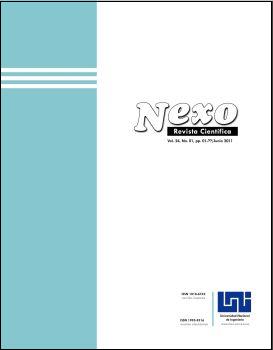Study of lactic acid fermentation for the extraction of chitin from shellfish waste
DOI:
https://doi.org/10.5377/nexo.v24i1.592Keywords:
Chitin, Shrimp shell, Sucrose, Vertical reactor, WheyAbstract
The extraction of chitin from crustacean waste involved the deproteinisation and demineralisation of crustacean shells using lactic acid fermentation with whey and sucrose as culture medium and carbon source, respectively. The fermentation process was carried out in a vertical Pyrex reactor of 4 L by 2 and 3 weeks at room temperature. The results showed that a good deproteinisation and demineralisation was obtained; however, the product still contained traces of proteins and pigments. Therefore, it was necessary to apply a chemical process with sodium hydroxide and sodium hypochlorite, to completely remove the proteins and pigments from the structure of crustacean shell. A recovery of 85 % was obtained. The comparison of FT-IR spectra of chitin produced and a sample of commercial chitin showed a correlation rate of 93-95 %, indicating that chitin produced using the combined method has a high degree of purity.
Keywords: Chitin; Shrimp shell; Sucrose; Vertical reactor; Whey
DOI: http://dx.doi.org/10.5377/nexo.v24i1.592
Nexo, Vol. 24, No. 1, pp. 33-42, 2011
Downloads
13320
Downloads
How to Cite
Issue
Section
License
The authors who publish in Nexo Scientific Journal agree to the following terms:
- Authors retain the copyright and grant the journal the right of the first publication under the license Creative Commons Attribution License, which allows others to share the work with a recognition of the authorship of the work and the initial publication in Nexo Scientific Journal.
- Authors may separately establish additional agreements for the non-exclusive distribution of the version of the work published in the journal (for example, in an institutional repository or a book), with the recognition of the initial publication in Nexo Scientific Journal.
- Authors are allowed and encouraged to disseminate their works electronically (for example, in institutional repositories or in their own website) before and during the submission process, as it can lead to productive exchanges, as well as earlier and greater citation of published works.










